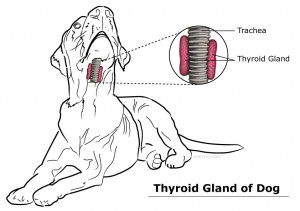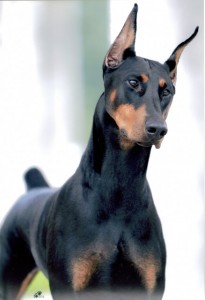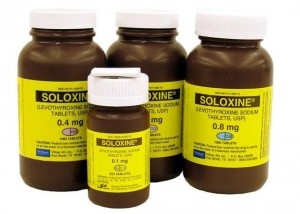In last week’s post, I discussed hyperthyroidism is cats. You may recall that hyperthyroidism occurs quite infrequently in dogs. Rather they more commonly develop a state of low thyroid production – hypothyroidism. Remember thyroid hormones are produced by the thyroid glands in the neck, and are important in controlling growth and development.
Image courtesy of www.petadviser.com
What does a dog with hypothyroidism look like?
Hypothyroidism occurs most frequently in middle-aged, medium-to-large breed dogs, and certain breeds (Golden retrievers, Doberman pinschers, Irish setters) are over-represented.
Common clinical signs of hypothyroidism include
- Sluggishness / reduced activity level
- Reduced ability to tolerate cold temperatures
- Weight gain
- Thinning or loss of hair
- Failure to regrow hair after clipping
- Poor wound healing
- Dull hair coat
- Excess shedding
- Scaly or oily hair coat
- Regurgitation
- Chronic ear or skin infections
- Face drooping (often called a ‘tragic’ expression)
Note the sad or tragic expression on the face of this Labrador retriever (photo courtesy of www.DogAware.com).
Are there different types of hypothyroidism?
Technically there are different types of hypothyroidism. The most common is called primary hypothyroidism. In this form, the immune system induces inflammation in the thyroid glands to disrupt normal function (lymphocytic thyroiditis). Cancer cells invading the thyroid glands can very rarely cause primary hypothyroidism. Occasionally the immune system can affect other hormone-producing glands to induce dysfunction at these sites, including the adrenal glands (Addison’s disease), parathyroid glands (hypoparathyroidism) and the pancreas (diabetes mellitus). Consultation with a board-certified veterinary internal medicine specialist can be quite helpful when evaluating these patients. Secondary and tertiary hypothyroidism are extremely uncommon, and are caused by abnormalities in the pituitary gland and hypothalamus, respectively. Usually dogs with these forms have other serious clinical signs in addition to those referable to hypothyroidism.
How is hypothyroidism diagnosed?
The decision to pursue testing for hypothyroidism in dogs should be based on the presence of clinical signs consistent with the disease. There are many different thyroid hormones, and proper diagnosis of hypothyroidism requires evaluation of them. Unfortunately in my experience, thorough assessment of these hormones is not commonly performed, and subsequently hypothyroidism is frequently over-diagnosed. Many primary care veterinarians measure a hormone called total thyroxine or tT4, and when a low tT4 level is documented, a dog is diagnosed with hypothyroidism. This sounds reasonable, right? Unfortunately diagnosis of hypothyroidism is more complicated. Total thyroxine is affected by numerous factors, and concurrent illness and certain drugs can lower tT4 levels to create the appearance of hypothyroidism even when the thyroid glands are normal. This is a common phenomenon known as sick euthyroid syndrome.
Board-certified veterinary internal medicine specialists strongly recommend evaluating a thyroid profile or panel (performed at a veterinary reference laboratory), a non-invasive blood test that evaluates multiple thyroid hormones, including:
- Total thyroxine (tT4)
- Free thyroxine (fT4) by equilibrium dialysis (ED)
- Thyroid stimulating hormone (TSH)
- Thyroglobulin autoantibodies (TgAA)
For a majority of dogs this thyroid profile is sufficient to accurately diagnose hypothyroidism. Rarely an additional blood test called thyrotropin releasing hormone (TRH) stimulation test is needed to make a definitive diagnosis. As always, test results must always be considered in light of a patient’s whole clinical picture.
How is hypothyroidism treated?
Hypothyroidism is treated by giving oral (by mouth) supplementation of a thyroid hormone.
Supplementation of thyroid hormone without a definitive diagnosis not recommended.
Excess thyroid hormone supplementation can cause aggressiveness, irritability, hyperactivity, increased appetite, weight loss, and/or excessive drinking and urinating.
There are two forms of thyroid supplementation – thyroxine (T4) and triiodothyronine (T3). In the body, T4 is converted to T3, and thus almost all hypothyroid dogs receive T4 supplementation (levothyroxine, L-thyroxine).
A small number of hypothyroid dogs are not able to convert T4 into T3, and thus this population requires supplementation with T3. The dose required to effectively treat dogs is variable, and for this reason, periodic blood drug level monitoring is strongly recommended. Pet parents should see an improvement in their dog’s activity level within a few weeks of initiating supplementation. Normalization of skin and hair coat changes may take several months. Failure to document appropriate clinical progress should raise concerns for inappropriate drug dosing and/or a concurrent disease process. Consultation with a board-certified veterinary internal medicine specialist may be very helpful for these patients. Once hypothyroidism is appropriately controlled, quarterly monitoring is recommended, and measurement of tT4 alone is adequate for this purpose.
The take-away message about hypothyroidism…
An accurate diagnosis requires a thorough evaluation of a patient’s history, physical examination and complete test results. Supplementation of thyroid hormone is well tolerated. When diagnosed and treated properly, dogs living with hypothyroidism can live a normal, high-quality lifestyle.
To find a board-certified veterinary internal medicine specialist, please visit the American College of Veterinary Internal Medicine.
Wishing you wet-nosed kisses,
cgb










